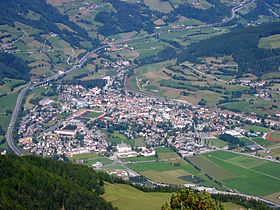This is an old revision of this page, as edited by Giovanni Giove (talk | contribs) at 16:23, 15 November 2007 (→Italianization today: DELETED: the present article is about "Fascist Italianization"). The present address (URL) is a permanent link to this revision, which may differ significantly from the current revision.
Revision as of 16:23, 15 November 2007 by Giovanni Giove (talk | contribs) (→Italianization today: DELETED: the present article is about "Fascist Italianization")(diff) ← Previous revision | Latest revision (diff) | Newer revision → (diff)| It has been suggested that this article be merged with Italianization and Talk:Italianization#Merger proposal. (Discuss) Proposed since November 2007. |

The fascist Italianization is the process by which, between 1924 and 1945, the Fascist government of Benito Mussolini forced foreign populations living in Italy to assume Italian culture and language.
This program of Italianization aimed to adsorb the linguistic and dialectal minorities living in Italy. The groups with a specific national identity were Slovenes and Croats in Venezia Giulia and Zara and Austrians around Bolzano (Bozen) and in "Val Canale". Under the program the foreign groups were forced to attend Italian language schools and use only the Italian language in public (including churches). The minorities institutions were closed, foreign toponyms, such as several surnames, were translated. Immigration of Italians from other regions of Italy was encouraged in Bolzano.
On the other side Italians names Germanized or Slavicized under the Austrian Empire, were restored in the original form.
Venezia Giulia and Dalmatia
With regard to Venezia Giulia and Dalmatia, some Slovenians and Croatians willingly accepted Italianization as a compromise required in order to gain full status as Italian citizens, and favour upward social mobility; most, however, resisted, as far as possible, these policies, sometimes with the support of local Catholic clergy. A Slovenian choirmaster Lojze Bratuž, who led several Slovenian language church choirs and thus resisted persecution of Slovenians in the area around Gorizia, was arrested on December 27 1936, tortured and forced to drink gasoline and motor oil.
Dodencanese
The policy affected also the inhabitants of Dodecanese, conquered by Italy in 1912. Although the islands were overwhelmingly Greek-speaking, punctuated only by a relatively small Turkish-speaking minority and even smaller Ladino-speaking Jewish minority (with few Italian speakers), schools were required to teach in Italian, and the Greek Orthodox religion of most of the inhabitants was strongly discouraged. These measures caused a good deal of Greek emigration from the islands, replaced by a moderate amount of Italian immigration.
Venezia Tridentina (Bolzano)
In 1939 Hitler and Mussolini reached an agreement on the status of Germans living in the Venezia Tridentina, in the province of Bolzano: they could emigrate to Germany and in the Greater German Reich's territory of Crimea or stay in Italy and accept their complete Italianization. As a consequence of this "Option in South Tyrol," South Tyrolean society was deeply riven. Those who wanted to stay ("Dableiber"), were condemned as traitors, those who left ("Optanten") were defamed as Nazis. Because of the outbreak of the World War II, this agreement was never fully accomplished.
Italianization of the language
In the 1930s a program of Italianization of the language was started. Foreign words were forbidden and new Italian words were created (such "calcio" instead of "football", or "consociazione" instead of "club").
In a minor extent, the program involved the grammar. "Lei", the singular formal form of "you" in Italian (informal : tu), was changed into "voi" (you, plural).
See also
- Italianisation
- Cultural assimilation
- Linguicide
- Italia irredenta
- Option in South Tyrol
- Prontuario dei nomi locali dell'Alto Adige
- TIGR
References
- Regio decreto legge 10 Gennaio 1926, n. 17: Restituzione in forma italiana dei cognomi delle famiglie della provincia di Trento